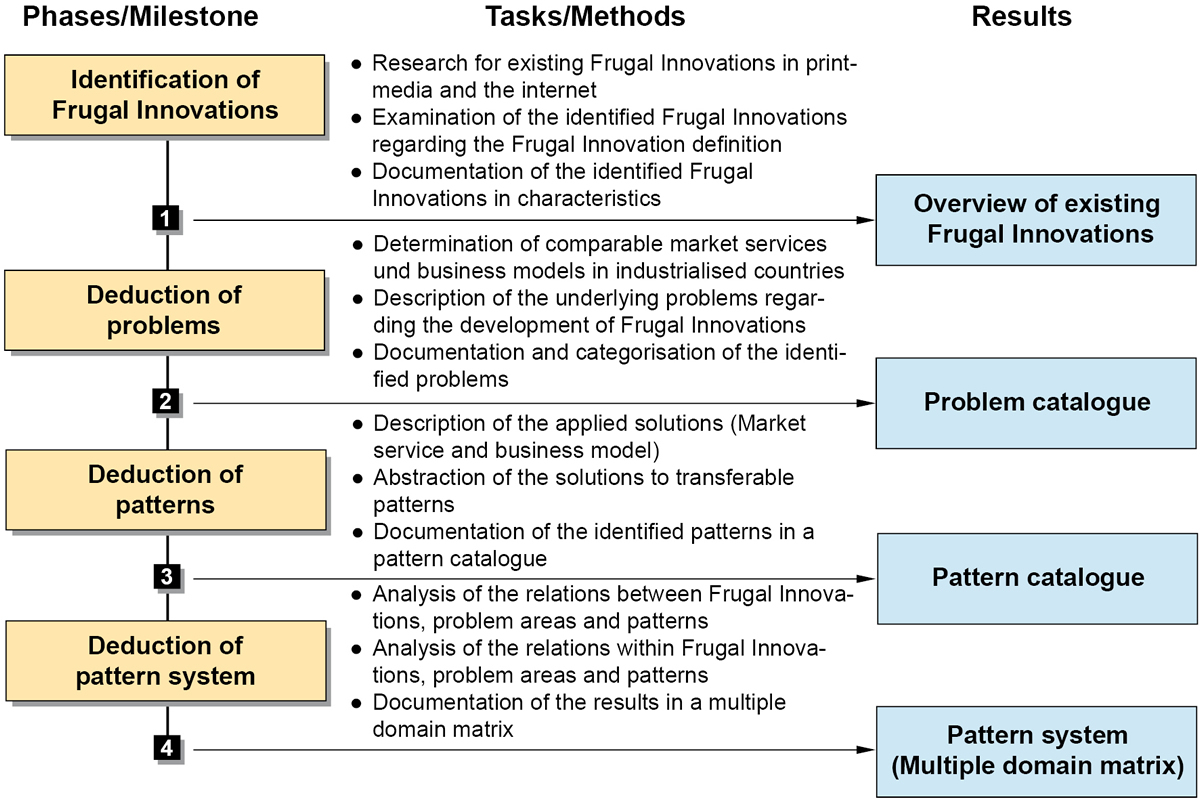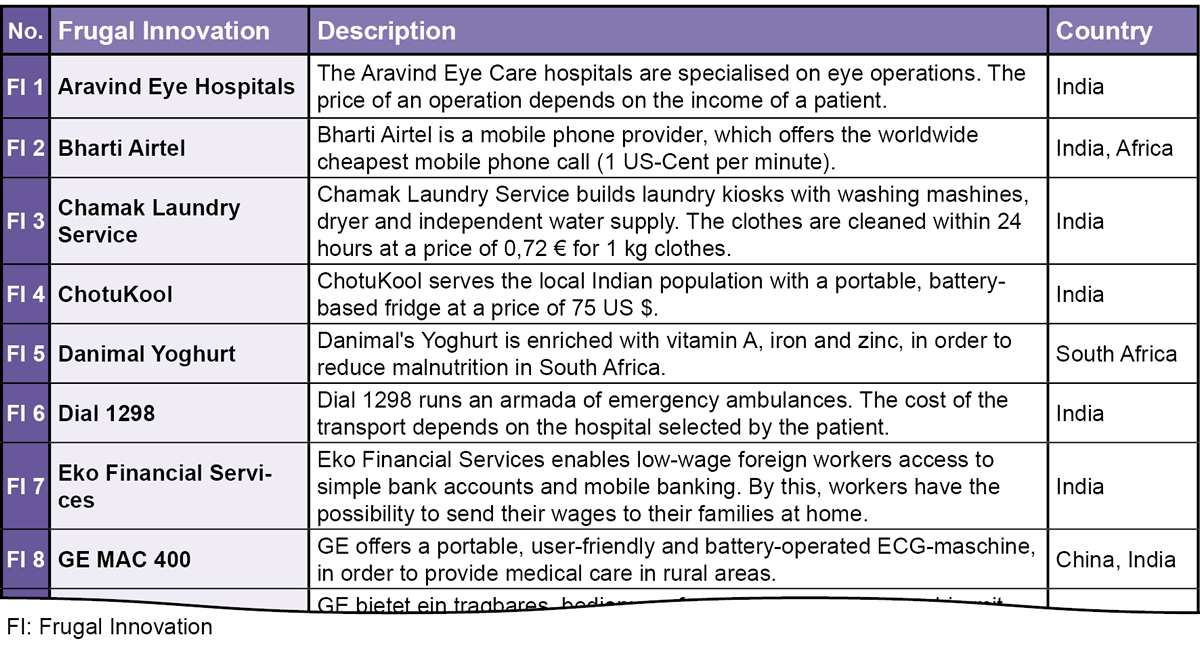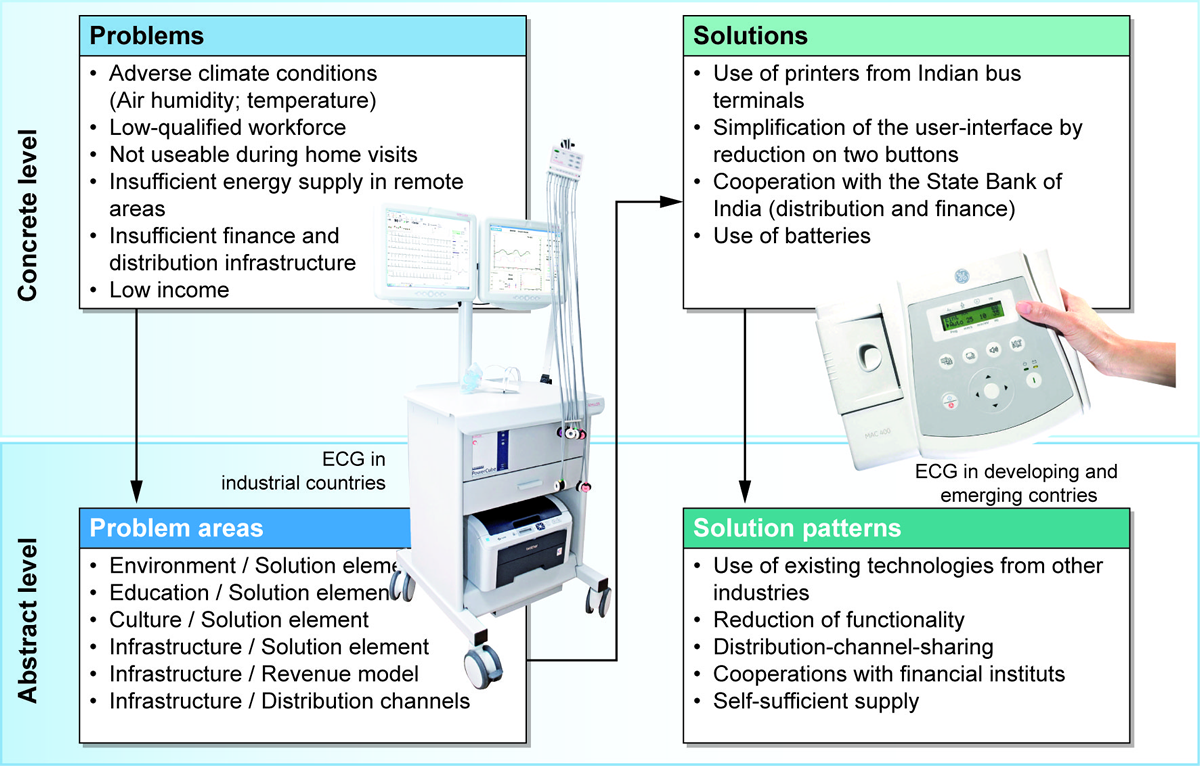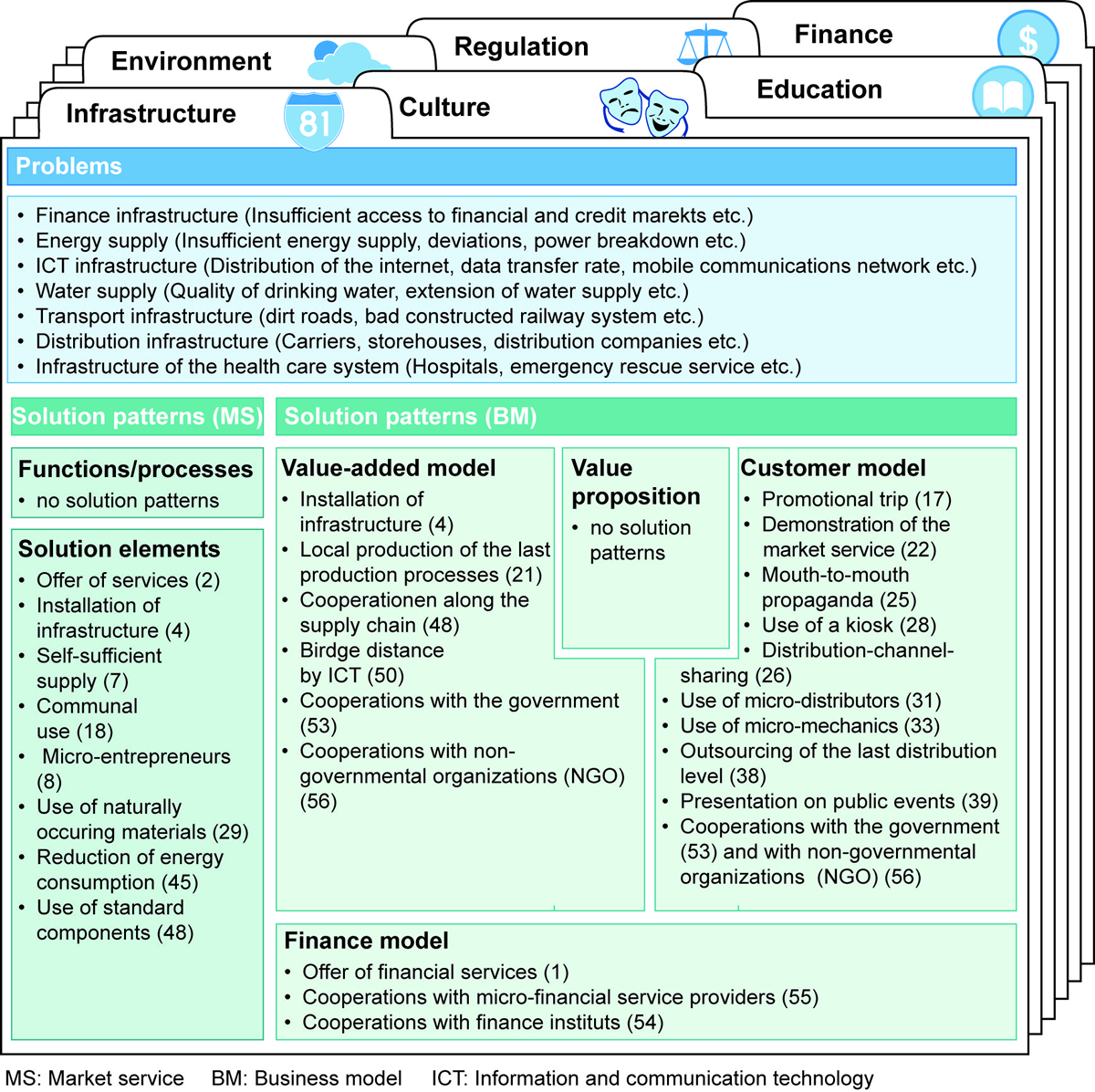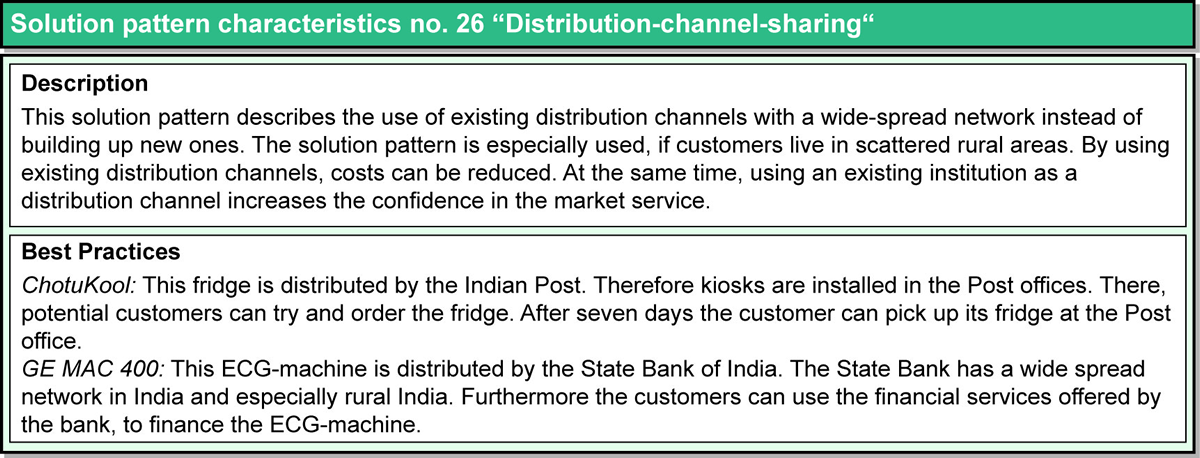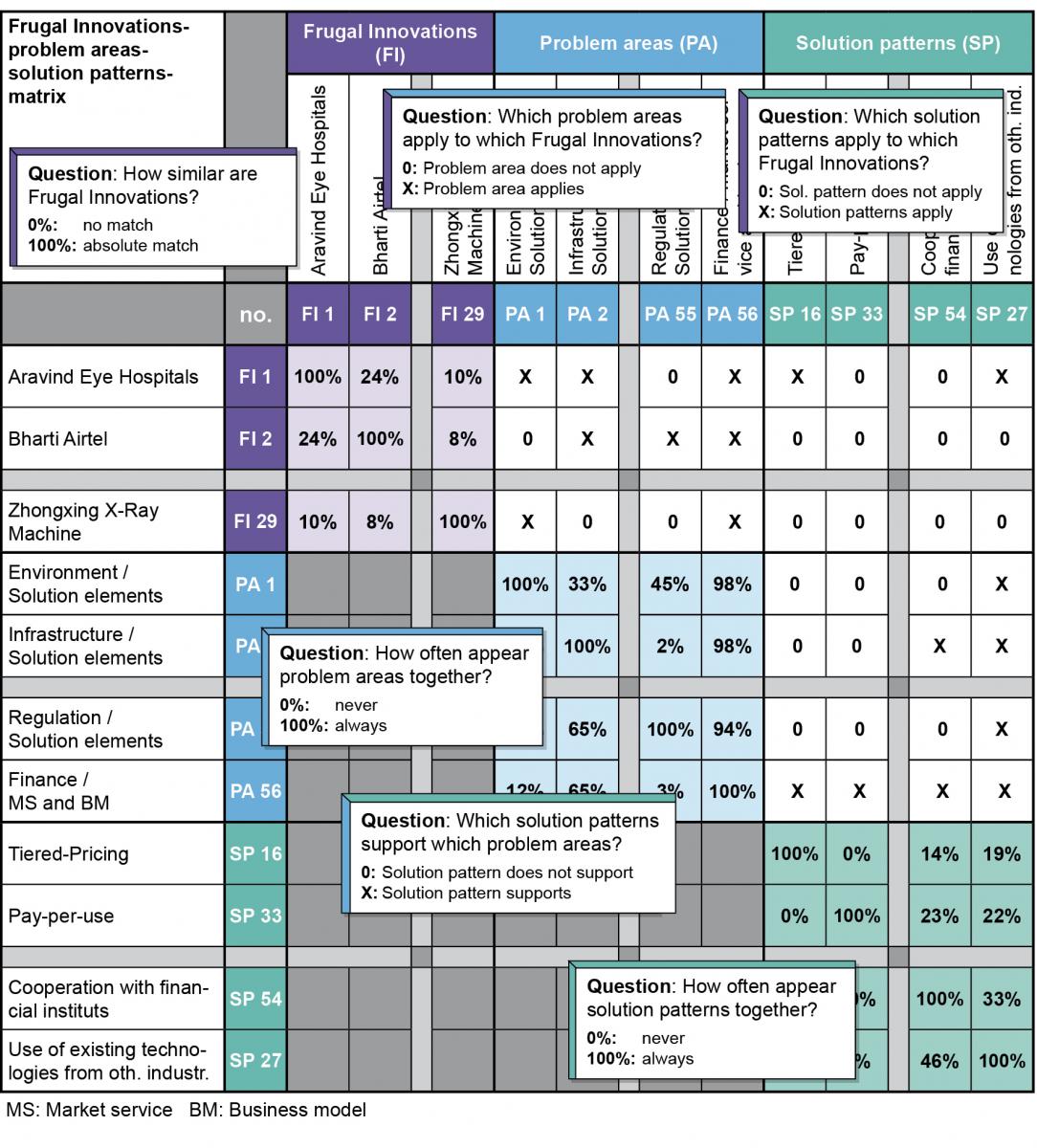AbstractCreativity and insight almost always involve an experience of acute pattern recognition: the eureka moment in which we perceive the interconnection between disparate concepts or ideas to reveal something new.
Jason Silva
Television personality, filmmaker, and public speaker
The economic rise of emerging markets induces a rapid growth of the global middle class. This new mass market demands products and services adapted to the needs of the local population – so called "frugal innovations". Engineers often face similar challenges while developing products and services for these markets, and therefore may develop similar solutions. By the abstraction of these solutions to transferrable solution patterns, the efficiency of the development process could be increased. In this article, we introduce a systematic approach to develop a pattern system for frugal innovations. Based on 29 selected frugal innovations, we derived the problems that led to the development of the analyzed frugal innovations. By categorizing these problems, we deduced six problem categories: education, environment, culture, infrastructure, regulation, and finance. We stripped down the solutions to these problems to their core principles, and in our subsequent analysis, we identified 56 solution patterns. Moreover, we analyzed the relationships between the abstracted solution patterns, problem areas, and frugal innovations. By using a pattern-based approach, the efficiency of the product development process could be improved significantly. As well, patterns may generate new impetus and increase creativity.
Introduction
The economic rise of emerging and developing countries induces a rapid growth of the global intermediate layer , which will grow from 4.9 billion humans in 2010 to nearly triple that number by 2030 (Credit Suisse AG, 2010; Ernst & Young, 2011, 2013). Eighty-five percent of this increase will come from the Asian continent (OECD, 2010; Roland Berger, 2013), and 40% of the consumption is predicted to be generated in China and India in 2030 (Ernst & Young, 2011).
The emerging mass markets demand low-cost products and services that are adapted to the needs of the local populations. In the literature, such market services are named “frugal innovations” (Basu et al., 2013; The Economist, 2010). Frugal innovations are distinguished by a high robustness, functionality, user friendliness, and low price (Roland Berger, 2013). However, the concept of frugal innovations is not limited to developing countries and newly industrializing countries: the number of price sensitive customers in industrial countries demanding frugal products will also increase (A.T. Kearney, 2012; Bhatti & Ventresca, 2013).
Companies often face several problems in developing market services and business models for these markets; in particular, they lack knowledge regarding local conditions and customer needs. Their developed solutions are often too costly and do not fit into the environment. Patterns provide solutions for recurring problems. Based on the hypothesis that many of the problems a developer faces in emerging markets are recurrent, patterns can make a substantial contribution to the development process.
In this article, we explain our pattern-based approach to the development of frugal innovations. We start with a short introduction to the concept of frugal innovations. Afterwards, the transmission of the pattern approach onto the development of frugal innovations is explained. In the main section, we describe how we derived frugal innovation patterns and developed a frugal innovation pattern system. Finally, we summarize the results and provide conclusions.
Defining Frugal Innovations
Frugal innovations are a relatively new field of research, which has been gaining in importance in practical and academic discourse during recent years (Bhatti & Ventresca, 2013). The roots of frugal innovation can be traced back to Carlos Ghosn, Chairman and Director of Renault-Nissan, who in 2006 introduced "frugal engineering" as “achieving more with fewer resources” (Kumar & Puranam, 2012). The term frugal innovation became established by the article “First Break All the Rules – The Charms of Frugal Innovation”, which was published in The Economist in 2010. In that article frugal innovations were described as products that are “stripped down to their bare essentials” and “take the needs of poor consumers as a starting point” (The Economist, 2010). In the course of the increasing academic interest, more definitions of frugal innovations were developed. The differences between the existing definitions can be understood with the help of three questions (Lehner et al., 2015), which are described in the subsections that follow.
1. What are the characteristics of frugal innovations?
An essential difference between the definitions are the assigned characteristics. Price is the main characteristic of many definitions (Bound & Thornton, 2012; Tiwari & Herstatt, 2014. Zeschky, Widenmayer, and Gassmann (2011) define frugal innovations as products with an external cost advantage in comparison to conventional solutions. In addition to the cost advantage, the scientists of the Frugal Innovation Lab of Santa Clara University define frugal innovations as “appropriate, adaptable, affordable, and accessible” (Basu et al., 2013). According to Bhatti (2012), frugal innovations are characterized by sustainability. Bound and Thornton (2012) point out that frugal innovations often offer a social benefit. Accordingly, a bulk of the common definitions refer to characteristics of frugal innovations that go beyond the cost advantage.
2. Which application areas do frugal innovations address?
The existing definitions differ in the application areas. Whereas the definition of Zeschky and colleagues. (2011) only considers products, Basu, Banerjee, and Sweeny. (2013) and Bound and Thornton (2012) add services. George McGahan, and Prabhu (2012) as well as Bhatti and Ventresca (2013) consider a frugal innovation as a type of business model innovation. The most extensive definition is used by Tiwari and Herstatt (2014): frugal innovations are “products (both goods and services), processes, or marketing and organizational methods”. Table 1 shows the three main application areas and exemplary frugal innovations.
Table 1. Application areas and exemplary frugal innovations
3. Where are frugal innovations developed and sold?
A further differentiating factor is the development site and the key market. Some researchers restrict the development site to developing countries and newly industrializing countries (e.g., George et al., 2012; Eager et al., 2011). Others argue that frugal innovations are also demanded by consumers from industrialized countries (e.g., Bhatti & Ventresca, 2013).
For the purposes of this article, we define a frugal innovation as a new or significantly changed product, market service, or business model that is based on the local conditions and customer needs in developing and emerging markets.
Transmission of the Pattern Approach onto the Development of Frugal Innovations
The pattern approach can be traced back to the activities of the architect Alexander. In the 1970s, he developed 253 patterns to design cities, buildings, and constructions. His idea was to document recurrent solution principles in form of patterns. According to Alexander, a pattern “describes a problem that occurs over and over again in our environment, and then describes the core of the solution to that problem, in such a way that you can use this solution a million times over, without ever doing it the same way twice” (Alexander et al., 1977).
A pattern generally does not stand alone. A bulk of patterns is called a pattern catalogue. If patterns are related to each other, we speak of a pattern system, which describes the dependence between the patterns, their implementation, and the process of finding solutions (Buschmann et al., 1996).
To this day, the pattern approach is still used by many different disciplines, including software engineering, product design, and business model development. With the aid of patterns, solutions can be externalized, structured, and documented; complexity and input are reduced and a uniform communication is created (Amshoff et al., 2014).
The transmission of the pattern approach to the development of frugal innovations is based on three hypotheses (Lehner et al., 2015):
- Product developers face similar problems while developing market services and business models for developing and newly industrializing countries (e.g., insufficient infrastructure, adverse climatic conditions, missing financial resources).
- If the problems are similar, the solutions will also be similar.
- By abstracting the applied solutions to patterns, they can be used to develop market services and business models with similar problems.
Besides the derivation of patterns, the insight of the underlying problems is one of the main aims of the analysis. One question is for example: Which problems necessitate the development of a frugal innovation, and how are these problems interconnected?
Development of a Pattern System for Frugal Innovations
To validate the first and second hypotheses and to deduce a pattern system, we used the procedure, described in Figure 1. It consists of four phases, which are explained in the following subsections.
Figure 1. Procedure to develop a pattern catalogue for frugal innovations
Phase 1: Identification of existing frugal innovations
In the literature, there are many market services and business models that are labelled as frugal innovations. First, we researched existing frugal innovations on the Internet and in print media and analyzed them according to our definition of frugal innovations. Market services and business models that were found to conform to all criteria (characteristics, application areas, development site, and key market) were selected and documented. Altogether, we used 29 frugal innovations in our analysis (Lehner et al., 2015). Table 2 shows an extract of the analyzed frugal innovations.
Table 2. Extract of the analyzed frugal innovations
Phase 2: Deduction of problems
In this phase, we analyzed the reasons for the development of a frugal innovation. In the first step, we identified comparable products, services, and business models for each selected frugal innovation. These are market services and business models that are placed in industrial countries and have a similar benefit or value proposition as the considered frugal innovation. For example, a comparable product for the Indian Tata Nano city car is the Volkswagen Up. And, the Aravind Eye Care Hospital is comparable to the eye clinics of the Charité in Berlin. Based on the comparable products and business models, we answered the question of why these products cannot be placed in developing countries. The determined problems were transferred to a list. Besides the obvious problems, such as differences in income, other problems were identified, such as different family structures. After the derivation of all problems for all selected frugal innovations, the results were collected and categorized. In total, six problem categories were identified: environment, infrastructure, education, culture, regulation, and finance.
Phase 3: Deduction of solution patterns
In order to identify the applied solution patterns, we analyzed the applied solutions to solve the problems identified in phase 2 (see Figure 2). The solutions can be an adaption of the market services (e.g., a reduction of the functionality), an adaption of the business model (e.g., an adaption of the revenue model), or both an adaption of the market service and business model. An example of the combined case is the communal use of a market service, which results in a modification of the market service concept as well as the concept of the business model. Afterwards, the identified solutions were abstracted until they just describe the core of the solutions. The number of times a pattern occurred had no influence: each abstracted solution for a problem was documented.
Figure 2 shows the results of the procedure using the example of frugal innovation number 8: the GE MAC 400, which is a portable, user-friendly, battery-powered electrocardiogram (ECG) machine. Due to its characteristics, it offers adequate services during home visits of patients in rural areas. Concrete problems relating to the use of a conventional ECG machine in an emerging country are counted amongst other problems, such as differences in income, differences in temperature, as well as insufficient power supplies in outlying areas.
Figure 2. Excerpt of the procedure to develop the solution pattern catalogue using the example of the GE MAC 400 electrocardiogram (ECG) machine
The printer that is built into a conventional ECG machine is designed to be used in a climate typical of an industrialized country, but cannot be used in the relatively high temperatures and humidity levels found in a developing country, in this case India. Instead, the frugal innovation adopted a printer that is used to print tickets in Indian bus terminals (Tiwari and Herstatt, 2014). The core of this solution is the transfer of existing solutions from other sectors to the problem under consideration. Accordingly, the pattern is called Use of existing technologies from other sectors. Further problems in this case were the absence of distribution and finance infrastructure. These problems are solved by General Electric (GE) in collaboration with the State Bank of India. The bank offers a widely ramified network in rural areas of India. Through this arrangement, GE could use the network of the bank for distribution and could simultaneously offer the solution at low cost. In addition, the confidence in the market services is strengthened by the cooperation with a regional company (Singh & Lillrank, 2015). The derived patterns are Cooperation with financial institutions and Distribution channel sharing.
All in all we identified 56 patterns for frugal innovations, which build together the pattern catalogue illustrated in Figure 3. In the pattern catalogue, the solutions are sorted by their underlying problem categories. A summary of all determined patterns for the problem category “Infrastructure” is shown the first index card in Figure 3.
Figure 3. An excerpt of the deduced solution patterns (Lehner et al., 2015)
Each pattern is briefly described by its characteristics. It consists of a short description of the solution pattern and its underlying problems. Furthermore, best practices are presented. Figure 4 shows an exemplary characteristic of solution pattern 26: Distribution channel sharing.
Figure 4. Exemplary characteristics solution pattern number 26: Distribution channel
sharing
Phase 4: Deduction of the solution pattern system
The targets of this phase are statements about the correlation between the solution patterns as well as the frugal innovations and problem areas. The correlations are visualised with the help of a multiple domain matrix (MDM). The domains, which are illustrated in the matrix in Figure 5, are frugal innovations, problem areas, and solution patterns. The description of the pattern system in this way is somewhat unconventional, but it indicates dependencies between patterns as in the “normal” network descriptions.
The filling of the matrix takes place in two steps. Based on the analysis of the earlier phases, the upper right triangle is filled. The diagonal matrices are derived from the matrices of the upper right triangle in the second step. The matrices of the upper right triangle are explained as follows:
- The frugal innovation problem-area matrix indicates which problem areas apply to which frugal innovation. The required data is discussed in Phase 2. For example, problem areas 1 (Environment/solution elements) and 56 (Finance/market services and business model) apply to frugal innovation 1 (Aravind Eye Hospitals).
- In the frugal innovation solution-pattern matrix, the determined solution patterns are assigned to the considered frugal innovations. This information is available from Phase 3 of the procedure. For example, frugal innovation 1 (Aravind Eye Hospitals) uses solution pattern 16 (Tiered pricing).
- In the problem areas solution-patterns matrix, indicates which patterns can be used to solve which problem areas. This information can also be derived from the results of Phase 3. For example, for problem area 56 (Finances/market services and business model), solution patterns 16 (Tiered pricing) and 33 (Pay per use) can be applied.
Figure 5. Matrix of frugal innovation problem areas and solution patterns
The three diagonal matrices are described as follows:
- Frugal innovation matrix: This matrix indicates the degree of similarity between two frugal innovations. The degree depends on the existing problem areas and used patterns of two compared frugal innovations. The frugal innovation matrix is a so-called diagonal mirrored matrix. Therefore, just the upper right triangle is calculated. In order to calculate the missing values, the matrix is mirrored on the diagonal. Two frugal innovations have the same problem areas and use the same patterns by a correspondence of 100%. The highest correspondence grade exists between frugal innovations 1 (Aravind Eye Care) and 28 (Narayana Health). These frugal innovations are two Indian hospital chains, which are specialized in different disease patterns The predominant problems are solved with a similar pattern combination. Beside these frugal innovations, which are from the same industry, there are other frugal innovations with a high agreement grade, which are resident in different sectors: the fridge ChotuKool and the ECG machine GE MAC 400.
- Problem area matrix: This matrix indicates how often a problem area j (column) appears when a problem area i (line) exists. In contrast to the frugal innovation matrix, it is a directional matrix. An evaluation of 100% implies that the problem area j (column) always exists together with the problem area i (line).
- Solution pattern matrix: In this matrix, the correlations between the patterns are analyzed. It indicates how often a pattern j (column) appears when a pattern i (line) exists. This matrix is also a directional matrix. A value of 0% means that a pattern j (column) is never used in cases where pattern i (line) exists. For example, this is the case with solution patterns 1 (Tiered pricing) and (Pay per use).
The pattern system provides an essential input to the development of frugal innovations. The choice of suitable patterns by given problem areas will be supported through the matrices of problem areas and solution patterns. Accordingly, conclusive pattern combinations can be identified.
Analysis of the Results
Based on the presented procedure, 56 solution patterns could be deduced from 29 selected frugal innovations. The most popular solution patterns are number 18 (Training of local talents) at 21%, number 34 (Use of natural resources) at 21%, and number 52 (Cooperation with the government) at 17%.
An analysis of the determined problem areas shows that the reasons for the development of a frugal innovation are based on financial (90%), infrastructural (72%), cultural (38%), and educational (38%) differences. In more than 74% of the analyzed frugal innovation, more than one problem category applies.
According to the allocation of the frugal innovations to the problem categories, 75% of the solution patterns deal with financial problems and approximately half deal with infrastructural problems. Just a few solution patterns support regulatory problems. However, 89% of the solution patterns focus on multiple problem areas; just 9% of the solution patterns address only financial problems.
The solution of the determined problems are solved by an adaptation of the market service or the business model: 60% of the analyzed solution patterns lead to changes of the business model, as seen in the solution pattern for Tiered pricing. The change of the revenue model seldom comes along with changes to the market service. And, 30% of the analyzed solution patterns are based on changes to the market service, as seen in the solution pattern Biometric identification, for example. Around 10% of the solution patterns lead to changes to the market service as well as the business model, as seen in the solution pattern Communal use. Regarding all frugal innovations, it becomes clear that it is not sufficient just to change the market service or business model. In most of the cases, it was and will be necessary to change both elements. Therefore, all of the analyzed frugal innovations use a combination of different solution patterns.
Conclusion
The pattern approach is already used successfully in many disciplines, and so its application to the development of frugal innovations seemed promising. The validation of the developed hypothesis confirms this expectation. Based on the presented procedure, 56 solution patterns for frugal innovations were identified. The high reutilization of the patterns shows that a transfer of pattern is reasonable and possible. In further research, it would be helpful to elaborate a pattern-based systematic approach to the development frugal innovations. This approach would require systematic derivation of the problem categories for a given market services and business models, the selection and combination of suitable solution patterns, as well as the transfer of the solution patterns to new application areas.
For practitioners, this article shows the relevance of existing knowledge regarding the development of frugal innovation. The article underlines that, whether using patterns or not, a glance beyond one owns business broadens the horizon and creates new ideas. The problems companies face in emerging markets have parallels to each other, and so we expect a pattern-based search to yield comparable solutions that are both fruitful and frugal.
Acknowledgements
An earlier version of this article was presented at the 2015 ISPIM Innovation Summit in Brisbane, Australia, December 6–9, 2015. ISPIM – the International Society for Professional Innovation Management – is a network of researchers, industrialists, consultants, and public bodies who share an interest in innovation management.
References
Alexander, C., Ishikawa, S., Silverstein, M., Jacobson, M., King, I. F., & Angel, S. 1977. A Pattern Language – Towns Buildings Construction. Oxford: Oxford University Press.
Amshoff, B., Dülme, C., Echterfeld, J., & Gausemeier, J. 2014. Geschäftsmodellmuster für disruptive Technologien. Berlin: Gausemeier, J.: Vorausschau und Technologieplanung. 10. Symposium für Vorausschau und Technologieplanung, November 20–21, 2014, HNI-Verlagsschriftenreihe, Band 334, Paderborn: 165–190.
Basu, R. R., Banerjee, P. M., & Sweeny, E. G. 2013. Frugal Innovation – Core Competencies to Address Global Sustainability. Journal of Management for Global Sustainability, 1(2): 63–82.
http://dx.doi.org/10.13185/JM2013.01204
Bhatti, Y. 2012. What Is Frugal, What Is Innovation? – Towards a Theory of Frugal Innovation. Oxford: Said Business School Working Paper Series.
Buschmann, F., Meunier, R., Rohnert, H., Sommerlad, P., & Stal, M. 1996. Pattern Orientated Software Architecture – A System of Patterns. Hoboken, NJ: Wiley.
Bound, K., & Thornton, I. 2012. Our Frugal Future – Lessons from India’s Innovation System. London: Nesta.
Bhatti, V., & Ventresca, M. 2013. How Can 'Frugal Innovation' Be Conceptualized? Oxford: Said Business School Working Paper Series.
Credit Suisse. 2010. Megatrends – Multipolar World. Frankfurt am Main: Credit Suisse AG.
The Economist. 2010. First Break All the Rules – The Charms of Frugal Innovation. The Economist, April 15, 2010. Accessed March 1, 2016:
http://www.economist.com/node/15879359
Eager, R., van Oene, F., Boulton, C., Roos, D., & Dekeyser, C. 2011. The Future of Innovation Management: The Next 10 Years. Prism, 1: 21–37.
Ernst & Young. 2011. Growing Beyond: Innovating for the Next Three Billions – The Rise of the Global Middle Class and How to Capitalize On It. London: Ernst & Young.
Ernst & Young. 2013. Hitting the Sweet Spot – The Growth of the Middle Class in Emerging Countries. London: Ernst & Young
George, G., McGahan, A. M., & Prabhu, J. 2012. Innovation for Inclusive Growth – Towards a Theoretical Framework and a Research Agenda. Journal of Management Studies, 49(4): 661–683.
http://dx.doi.org/10.1111/j.1467-6486.2012.01048.x
Kumar, N., & Puranam. P. 2012. India Inside – The Emerging Innovation Challenge to the West. Watertown, MA: Harvard Business Review Press.
Lehner, A.-C., Gausemeier, J., & Röltgen, D. 2015. Nutzung von Lösungsmustern bei der Entwicklung von Frugal innovations. Berlin: Gausemeier, Vorausschau und Technologieplanung. 11. Symposium für Vorausschau und Technologieplanung, October 29–30, 2015: 11–37.
OECD. 2010. The Emerging Middle Class in Developing Countries. Working Paper No. 285. Paris: OECD Development Centre.
Roland Berger. 2015. Frugal Products: Study Results. Stuttgart: Roland Berger Strategy Consultants.
http://www.rolandberger.com/media/pdf/Roland_Berger_Frugal_products_2013....
Singh, V. K., & Lillrank, P. 2015. Innovations in Health Care Management: Cost Effective and Sustainable Solutions. Boca Raton: CRC Press.
Shivaraman, S., Mathur, M., & Kidambi, R. 2012. Frugal Re-Engineering – Innovatively Cutting Product Costs. Chicago: A.T. Kearney.
Tiwari, R., & Herstatt, C. 2014. Aiming Big with Small Cars – Emergence of a Lead Market in India. Berlin: Springer Verlag.
Tiwari, R., & Herstatt C. 2014. Frugale Innovationen: Analogieeinsatz als Erfolgsfaktor in Schwellenländern. In C. Herstatt, K. Kalogerakis, & M. Schulthess (Eds.), Innovationen durch Wissenstransfer: 84–104. Wiesbaden: Springer Verlag.
http://dx.doi.org/10.1007/978-3-658-01566-4_4
Zeschky, M., Widenmayer, B., & Gassmann, O. 2011. Frugal Innovation in Emerging Markets. Research Technology Management, 54(4): 38–45.
http://dx.doi.org/10.5437/08956308X5404007
Keywords: business model, developing markets, emerging markets, frugal innovations, market service, pattern catalogue, pattern system, solution patterns


